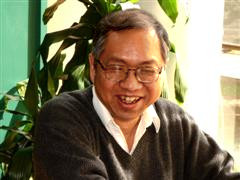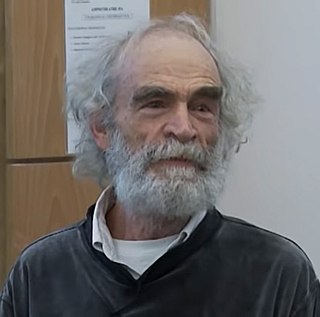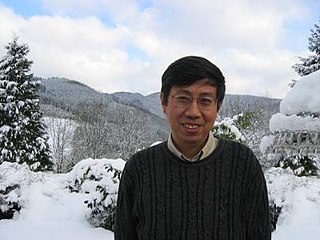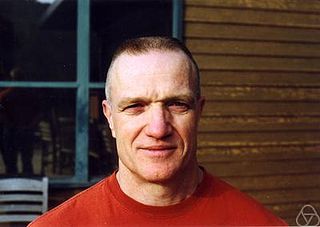Related Research Articles

In mathematics, complex geometry is the study of geometric structures and constructions arising out of, or described by, the complex numbers. In particular, complex geometry is concerned with the study of spaces such as complex manifolds and complex algebraic varieties, functions of several complex variables, and holomorphic constructions such as holomorphic vector bundles and coherent sheaves. Application of transcendental methods to algebraic geometry falls in this category, together with more geometric aspects of complex analysis.

In algebraic geometry, a Calabi–Yau manifold, also known as a Calabi–Yau space, is a particular type of manifold which has properties, such as Ricci flatness, yielding applications in theoretical physics. Particularly in superstring theory, the extra dimensions of spacetime are sometimes conjectured to take the form of a 6-dimensional Calabi–Yau manifold, which led to the idea of mirror symmetry. Their name was coined by Candelas et al. (1985), after Eugenio Calabi who first conjectured that such surfaces might exist, and Shing-Tung Yau (1978) who proved the Calabi conjecture.

Riemannian geometry is the branch of differential geometry that studies Riemannian manifolds, smooth manifolds with a Riemannian metric, i.e. with an inner product on the tangent space at each point that varies smoothly from point to point. This gives, in particular, local notions of angle, length of curves, surface area and volume. From those, some other global quantities can be derived by integrating local contributions.
In mathematics, the uniformization theorem says that every simply connected Riemann surface is conformally equivalent to one of three Riemann surfaces: the open unit disk, the complex plane, or the Riemann sphere. The theorem is a generalization of the Riemann mapping theorem from simply connected open subsets of the plane to arbitrary simply connected Riemann surfaces.

Shing-Tung Yau is a Chinese-American mathematician and the William Caspar Graustein Professor of Mathematics at Harvard University. In April 2022, Yau announced retirement from Harvard to become Chair Professor of mathematics at Tsinghua University.

Armand Borel was a Swiss mathematician, born in La Chaux-de-Fonds, and was a permanent professor at the Institute for Advanced Study in Princeton, New Jersey, United States from 1957 to 1993. He worked in algebraic topology, in the theory of Lie groups, and was one of the creators of the contemporary theory of linear algebraic groups.
In mathematics and especially differential geometry, a Kähler manifold is a manifold with three mutually compatible structures: a complex structure, a Riemannian structure, and a symplectic structure. The concept was first studied by Jan Arnoldus Schouten and David van Dantzig in 1930, and then introduced by Erich Kähler in 1933. The terminology has been fixed by André Weil. Kähler geometry refers to the study of Kähler manifolds, their geometry and topology, as well as the study of structures and constructions that can be performed on Kähler manifolds, such as the existence of special connections like Hermitian Yang–Mills connections, or special metrics such as Kähler–Einstein metrics.
In mathematics, Hodge theory, named after W. V. D. Hodge, is a method for studying the cohomology groups of a smooth manifold M using partial differential equations. The key observation is that, given a Riemannian metric on M, every cohomology class has a canonical representative, a differential form that vanishes under the Laplacian operator of the metric. Such forms are called harmonic.

Mikhael Leonidovich Gromov is a Russian-French mathematician known for his work in geometry, analysis and group theory. He is a permanent member of IHÉS in France and a Professor of Mathematics at New York University.
In the mathematical field of differential geometry, there are various splitting theorems on when a pseudo-Riemannian manifold can be given as a metric product. The best-known is the Cheeger–Gromoll splitting theorem for Riemannian manifolds, although there has also been research into splitting of Lorentzian manifolds.
In mathematics, the soul theorem is a theorem of Riemannian geometry that largely reduces the study of complete manifolds of non-negative sectional curvature to that of the compact case. Jeff Cheeger and Detlef Gromoll proved the theorem in 1972 by generalizing a 1969 result of Gromoll and Wolfgang Meyer. The related soul conjecture, formulated by Cheeger and Gromoll at that time, was proved twenty years later by Grigori Perelman.
The mathematical term perverse sheaves refers to a certain abelian category associated to a topological space X, which may be a real or complex manifold, or a more general topologically stratified space, usually singular. This concept was introduced in the thesis of Zoghman Mebkhout, gaining more popularity after the (independent) work of Joseph Bernstein, Alexander Beilinson, and Pierre Deligne (1982) as a formalisation of the Riemann-Hilbert correspondence, which related the topology of singular spaces and the algebraic theory of differential equations. It was clear from the outset that perverse sheaves are fundamental mathematical objects at the crossroads of algebraic geometry, topology, analysis and differential equations. They also play an important role in number theory, algebra, and representation theory. The properties characterizing perverse sheaves already appeared in the 75's paper of Kashiwara on the constructibility of solutions of holonomic D-modules.

Richard Melvin Schoen is an American mathematician known for his work in differential geometry and geometric analysis. He is best known for the resolution of the Yamabe problem in 1984.
In mathematics, specifically in algebraic geometry and algebraic topology, the Lefschetz hyperplane theorem is a precise statement of certain relations between the shape of an algebraic variety and the shape of its subvarieties. More precisely, the theorem says that for a variety X embedded in projective space and a hyperplane section Y, the homology, cohomology, and homotopy groups of X determine those of Y. A result of this kind was first stated by Solomon Lefschetz for homology groups of complex algebraic varieties. Similar results have since been found for homotopy groups, in positive characteristic, and in other homology and cohomology theories.

Tian Gang is a Chinese mathematician. He is a professor of mathematics at Peking University and Higgins Professor Emeritus at Princeton University. He is known for contributions to the mathematical fields of Kähler geometry, Gromov-Witten theory, and geometric analysis.
Steven Mark Zucker was an American mathematician who introduced the Zucker conjecture, proved in different ways by Eduard Looijenga (1988) and by Leslie Saper and Mark Stern (1990).

Jeff Cheeger is a mathematician. Cheeger is professor at the Courant Institute of Mathematical Sciences at New York University in New York City. His main interests are differential geometry and its connections with topology and analysis.
The Geometry Festival is an annual mathematics conference held in the United States.

Robert Leamon Bryant is an American mathematician. He works at Duke University and specializes in differential geometry.
In mathematics, a Novikov–Shubin invariant, introduced by Sergei Novikov and Mikhail Shubin (1986), is an invariant of a compact Riemannian manifold related to the spectrum of the Laplace operator acting on square-integrable differential forms on its universal cover.
References
- Atiyah, Michael F. (1976). "Elliptic operators, discrete groups and von Neumann algebras". Colloque "Analyse et Topologie" en l'Honneur de Henri Cartan (Orsay, 1974). Paris: Soc. Math. France. pp. 43–72. Astérisque, No. 32–33.
- Gordon, B. Brent (2001) [1994], "Baily–Borel compactification", Encyclopedia of Mathematics , EMS Press
- Cheeger, Jeff (1983), "Spectral geometry of singular Riemannian spaces", Journal of Differential Geometry , 18 (4): 575–657, doi: 10.4310/jdg/1214438175 , MR 0730920
- Cheeger, Jeff (1980). "On the Hodge theory of Riemannian pseudomanifolds". Geometry of the Laplace operator. Proc. Sympos. Pure Math. Vol. 36. Providence, R.I.: American Mathematical Society. pp. 91–146. MR 0573430.
- Cheeger, Jeff (1979). "On the spectral geometry of spaces with cone-like singularities". Proc. Natl. Acad. Sci. U.S.A. 76 (5): 2103–2106. Bibcode:1979PNAS...76.2103C. doi: 10.1073/pnas.76.5.2103 . MR 0530173. PMC 383544 . PMID 16592646.
- Cheeger, J.; Goresky, M.; MacPherson, R. "L2 cohomology and intersection homology for singular algebraic varieties". Seminar on Differential Geometry. Annals of Mathematics Studies. Vol. 102. pp. 303–340. MR 0645745.
- Mark Goresky, L2 cohomology is intersection cohomology
- Frances Kirwan, Jonathan Woolf An Introduction to Intersection Homology Theory,, chapter 6 ISBN 1-58488-184-4
- Looijenga, Eduard (1988). "L2-cohomology of locally symmetric varieties". Compositio Mathematica . 67 (1): 3–20. MR 0949269.
- Lück, Wolfgang (2002). L2-invariants: theory and applications to geometry and K-theory. Ergebnisse der Mathematik und ihrer Grenzgebiete. 3. Folge. A Series of Modern Surveys in Mathematics [Results in Mathematics and Related Areas. 3rd Series. A Series of Modern Surveys in Mathematics]. Vol. 44. Berlin: Springer-Verlag. ISBN 3-540-43566-2.
- Saper, Leslie; Stern, Mark (1990). "L2-cohomology of arithmetic varieties". Annals of Mathematics . Second Series. 132 (1): 1–69. doi:10.2307/1971500. JSTOR 1971500. MR 1059935.
- Zucker, Steven (1978). "Théorie de Hodge à coefficients dégénérescents". Compt. Rend. Acad. Sci. 286: 1137–1140.
- Zucker, Steven (1979). "Hodge theory with degenerating coefficients: L2-cohomology in the Poincaré metric". Annals of Mathematics . 109 (3): 415–476. doi:10.2307/1971221. JSTOR 1971221.
- Zucker, Steven (1982). "L2-cohomology of warped products and arithmetic groups". Inventiones Mathematicae . 70 (2): 169–218. Bibcode:1982InMat..70..169Z. doi:10.1007/BF01390727. S2CID 121348276.